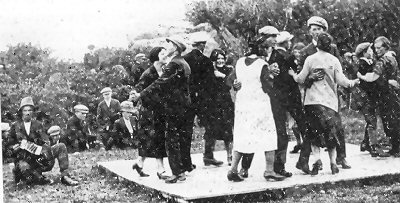Mr Thomas Mallon of Clontygora continued in similar vein:
‘A different mode was used for de-seeding wheat and oats. Then flails were used.
By the turn of the century (nineteenth to twentieth, that is) we were equipped with metal threshing machines pulled by a pair of horses which moved in a circular fashion. In such farms the same power was used for churning milk to make butter. The straw residue then was a valuable commodity, for animal bedding, thatching etc. and would be carted many miles to markets for sale.
A little handful of corn straw was gathered up and plaited and tied in a knot. It was done on the last day of the shearin’. It was cut from a butt an’ the fella who cut it carried it off into the house, where it wud be put above the dure-head for luck an’ left there to the nixt year.
That night there’d be a bit of a spread an’ plenty of whiskey, for it was as cheap then as buttermilk is today.’
This article hung above the door was known by various names, Corn Dolly or Calliagh among them.
‘I saw the Calliagh cut by the hook an’ I mind well seeing eleven or twelve oul’ weemin in one fiel’ shearin’. The lan’ was then in rigs an’ ivery woman had a rig. When it was cut it was taken home and hung in the kitchen.’ John Murray, Armaghbrague, 30 July 1942 ; then aged 85.
‘I don’t mind seeing the Calliagh cut but I know the way it was done in my father’s day, was be throwin’ the hook from a butt. That day the workers would torment the childer be sayin’, ‘when the Calliagh’s caught the day, we will be bringin’ it in till hang yer mother with!’ An’ the wee ones were frightened till death. It was always put about the neck of the woman of the house. That was the right thing till do.’
Mrs Mallon, wife of the above, who was a native of Ballintate in Ballymoyer Parish (Whitecross).
